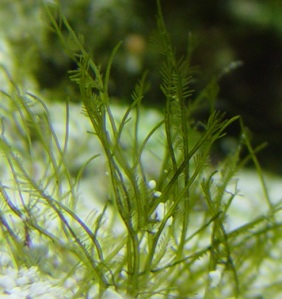Bryopsis has been one of the common nuisance algae in my local reef keeping community. I have had my share of battles with bryopsis in the past, and in my opinion, it is one of the most difficult nuisance algae to get rid of. This post will focus on suggested eradication methods specific to bryopsis in the saltwater aquarium.
Bryopsisidaceae Identification
Bryopsis’s shoots are small and erect and grow up to 10cm long. Its branches are observed with two vertical rows on opposite sides on the main axes. These lateral branches are uniform length and constricted at the base. The lower half of its branches are bare. Bryopsis forms bushy, tuft-like mats, and its fronds are feather-like and measure approximately 8-15 mm wide. Bryopsis’s root system is fibrous and tightly interwoven. Also, its color is usually dark green, often with blue iridescence.
Nuisance Alga
Bryopsis is highly opportunistic in environments with excessive nutrients or where water temperatures tend to fluctuate. This potentially invasive genus produces chemical defenses that are toxic to most herbivorous organisms and easily reproduces from the smallest fragments. Bryopsis is often referred to as Sea Fern and is usually introduced to aquariums on live rock.
Methods
- Manual removal. Although manual removal is recommended by some resources, this method requires the careful use of tools, such as tweezers and a siphon. This nuisance alga may also be sifted out of the sand. Precautions should be taken, as this may promote asexual reproduction via fragmentation.
- Freezing. This method involves placing affected live rock in the freezer for 48 hours or more. This process will burst the cellular structure of algae, thereby killing it. Following freezing, brush off or manually remove any remaining pieces that are visible before returning the rock to the display. Hobbyists should be aware that this method would also kill other living organisms present on the rock.
- pH. Another stated method is to use a combination of aggressive protein skimming and elevating pH levels to at least 8.5 for three weeks. Low pH and alkalinity ratios will aggravate outbreaks.
- Magnesium. The latest trend involves elevating levels of magnesium from normal range to 1500-1600 ppm. Most aquarists who have tried this method feel this is the fastest and least detrimental way to correct the dilemma. The theory behind this is that the magnesium stops the photosynthetic process in bryopsis, but it does not affect other desirable macroalgae and tank inhabitants. However, some hobbyists suspect that an elevated level of magnesium can kill desirable invertebrates. Gradual elevation is best, with no change greater than 100ppm per day. For this method to be effective, resources state that magnesium levels should remain elevated for at least 3 months.
- Light Deprivation. This method has been suggested by some resources and involves complete deprivation of light for at least three days utilizing reef-safe plastics.
- Predators. Most herbivores will not consume this nuisance algae. Some resources note that some tangs from the Zebrasoma and Ctenochaetus families may keep the algae in control. However, because bryopsis embeds itself deeply in live rock, complete eradication is difficult. Other fish that may assist in consuming this alga are the lawnmower blenny, Salarias fasciatus, and the bi-color blenny, Ecsenius bicolor. Other preferred tank inhabitants that may assist with natural removal include urchins of the diadema genus, pincushion urchins, nudibranches of the elysia genus, emerald mithrax crabs, and some hermit crabs. Tridachia crispa is a specialist feeder of bryopsis but may die once the outbreak has been resolved. If you decide to incorporate any of these tank inhabitants to your system, please perform the necessary research and ensure that your system is appropriate for these creatures.
From my personal experience, manual removal appeared to spread the bryopsis throughout my system due to fragmentation. The herbivores, dwarf blue leg hermit crabs and emerald mithrax crabs, that I introduced appeared uninterested in this specific type of alga. Overall, I feel that the combined use of light deprivation and elevated magnesium levels appeared the most effective.
Read more about bryopsis,
Allan, H. (2008). Bryopsis: A Common Pest in Aquaria. Retrieved from http://fish.suite101.com/article.cfm/bryopsis_a_common_pest_in_aquaria
FAQs about Genera Bryopsis & Derbesia Algae. (n.d.). Retrieved from http://www.wetwebmedia.com/BryopsisF.htm
Gibbons Aquaria, Inc. (2009). Nightmare Bryopsis Algae Problem: A Solution That Actually Works. Retrieved from http://saltwateraquariumsecrets.com/31/nightmare-bryopsis-algae-problem-a-solution-that-actually-works/
Hauter, S. & Hauter, D. (2010). Nuisance Green Macroalgae. Retrieved from http://saltaquarium.about.com/cs/algaecontrol/a/aa033001.htm
Killing Bryopsis with Elevated Levels of… (2007). Retrieved from http://forum.marinedepot.com/Topic67434-13-1.aspx
Upcoming Posts:
- Deciphering RO/DI Cartridge Information

Leave a comment